初中英语反义疑问句的用法归纳及操练
初中英语反义疑问句用法及练习
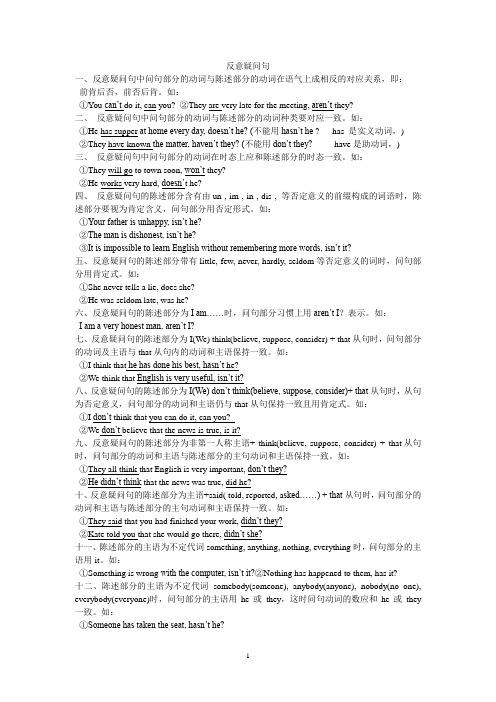
反意疑问句一、反意疑问句中问句部分的动词与陈述部分的动词在语气上成相反的对应关系,即:前肯后否,前否后肯。
如:①You can’t do it, can you? ②They are very late for the meeting, aren’t they?二、反意疑问句中问句部分的动词与陈述部分的动词种类要对应一致。
如:①He has supper at home every day, doesn’t he? (不能用hasn’t he ? has 是实义动词,)②They have known the matter, haven’t they? (不能用don’t they?have是助动词,)三、反意疑问句中问句部分的动词在时态上应和陈述部分的时态一致。
如:①They will go to town soon, won’t they?②He works very hard, doesn’t he?四、反意疑问句的陈述部分含有由un-, im-, in-, dis-, 等否定意义的前缀构成的词语时,陈述部分要视为肯定含义,问句部分用否定形式。
如:①Your father is unhappy, isn’t he?②The man is dishonest, isn’t he?③It is impossible to learn English without remembering more words, isn’t it?五、反意疑问句的陈述部分带有little, few, never, hardly, seldom等否定意义的词时,问句部分用肯定式。
如:①She never tells a lie, does she?②He was seldom late, was he?六、反意疑问句的陈述部分为I am……时,问句部分习惯上用aren’t I?表示。
如:I am a very honest man, aren’t I?七、反意疑问句的陈述部分为I(We) think(believe, suppose, consider) + that从句时,问句部分的动词及主语与that从句内的动词和主语保持一致。
初中英语反义疑问句归纳与练习
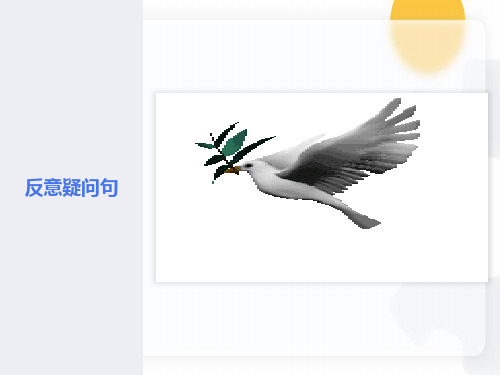
You'd like to go with me, wouldn't you?
带情态动词dare或need的反意疑问 句,疑问部分常用 need (dare ) + 主语。
We need not do it again, need we ?
4. 如果陈述部分用I’m…结构,附加疑问部分一般 用 aren’t I 如: I am strong and healthy, aren’t I?
5. 当陈述句为there be结构时,附加疑问句中的主 语也用there。如: There’s no help for it, is there? There’s something wrong, isn’t there?
you? 但若表推测这层含义时,不能用must,而要根 据陈述部分的不定式结构(即must之后的动 词)以及含义采用相应的动词形式。如: You must have made a mistake, haven’t you?
He must be in the library, isn’t he?
当陈述部分含有 had better时, 疑问部分用had.
5. 6.
Let us There
wdoertehfeejwobpseoouprlesetlhveerse, ,_____w__i__l_l__y___o__u__/__w__o?__n_’?t
you
7. You need to have a good dictiownaerrey,t_h_e_r_e_____?
如果陈述部分的否定词带有否定前缀,那么,该 陈述部分作肯定处理,附加疑问部分一般仍用否 定形式。如:
反义疑问句的用法归纳及习题

反义疑问句的用法归纳及习题反义疑问句是英语语法中的常用句型之一,它由一个肯定或否定的陈述句和一个所加的疑问句构成。
通过反义疑问句的使用,我们可以在表达思想观点时增强语气,提出问题的同时向对方确认自己的观点。
本文将介绍反义疑问句的用法,并提供相应的习题供读者进行练习。
一、反义疑问句的构成反义疑问句由两个部分组成:一个陈述句和一个疑问句。
陈述句通常是一个完整的句子,而疑问句则是一个简化的疑问句。
1. 如果陈述句是肯定句,则疑问句部分用否定形式;例如:- They are from China, aren't they?- You can swim, can't you?2. 如果陈述句是否定句,则疑问句部分用肯定形式;例如:- He doesn't like coffee, does he?- They haven't arrived yet, have they?二、反义疑问句的用法1. 确认对方的观点或陈述:当说话人对对方的陈述持怀疑态度时,可以使用反义疑问句来进行确认。
例如:- You haven't seen the movie, have you?- You don't like ice cream, do you?2. 请求对方的帮助或征求对方的意见:当说话人需要对方给予回应或意见时,可以使用反义疑问句来婉转地提出请求。
例如:- It's a beautiful day, isn't it? (期待对方赞同这个说法)- This problem is difficult, isn't it? (希望对方给予帮助或建议)3. 表达自己的观点或感受:反义疑问句也可以用来表达自己的观点或感受,并期待对方与自己保持一致或不一致。
例如:- She is a talented singer, isn't she?- You're not feeling well, are you?三、习题练习以下是一些习题,供读者练习反义疑问句的用法。
英语反义疑问句的14种常考特殊用法,备战中考一定要掌握!
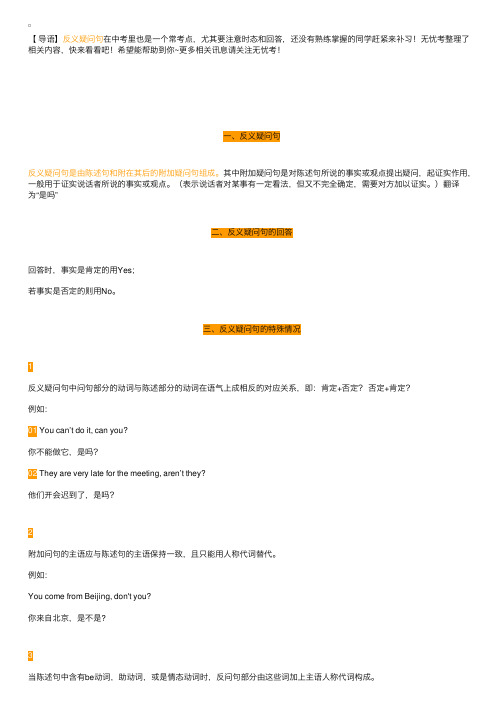
【导语】反义疑问句在中考⾥也是⼀个常考点,尤其要注意时态和回答,还没有熟练掌握的同学赶紧来补习!⽆忧考整理了相关内容,快来看看吧!希望能帮助到你~更多相关讯息请关注⽆忧考!⼀、反义疑问句反义疑问句是由陈述句和附在其后的附加疑问句组成。
其中附加疑问句是对陈述句所说的事实或观点提出疑问,起证实作⽤,⼀般⽤于证实说话者所说的事实或观点。
(表⽰说话者对某事有⼀定看法,但⼜不完全确定,需要对⽅加以证实。
)翻译为“是吗”⼆、反义疑问句的回答回答时,事实是肯定的⽤Yes;若事实是否定的则⽤No。
三、反义疑问句的特殊情况1反义疑问句中问句部分的动词与陈述部分的动词在语⽓上成相反的对应关系,即:肯定+否定?否定+肯定?例如:01 You can’t do it, can you?你不能做它,是吗?02 They are very late for the meeting, aren’t they?他们开会迟到了,是吗?2附加问句的主语应与陈述句的主语保持⼀致,且只能⽤⼈称代词替代。
例如:You come from Beijing, don't you?你来⾃北京,是不是?3当陈述句中含有be动词,助动词,或是情态动词时,反问句部分由这些词加上主语⼈称代词构成。
Be动词包括:am, is, are, was, were助动词有:do, does, did, have(⽤在完成时), has(⽤在完成时)等情态动词有:can, could, may, might, must, will, would, shall, should例如:01 He will go home, won’t he?他要回家了,是吗?02 She doesn’t like to eat popcorn, does she?她不喜欢吃爆⽶花,是吗?4have的不同⽤法,反义疑问句⽤不同的动词。
(1)have表“有”时,反义疑问句谓语动词⽤have/do都⾏。
反义疑问句知识点详解(初中英语专项复习)1
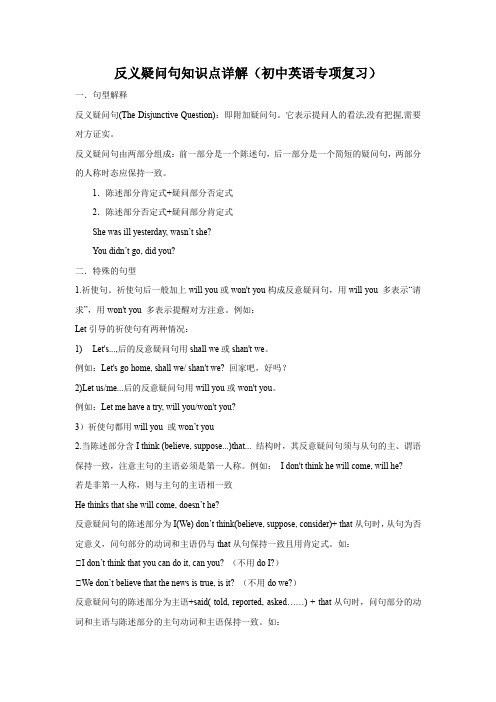
反义疑问句知识点详解(初中英语专项复习)一.句型解释反义疑问句(The Disjunctive Question):即附加疑问句。
它表示提问人的看法,没有把握,需要对方证实。
反义疑问句由两部分组成:前一部分是一个陈述句,后一部分是一个简短的疑问句,两部分的人称时态应保持一致。
1.陈述部分肯定式+疑问部分否定式2.陈述部分否定式+疑问部分肯定式She was ill yesterday, wasn’t she?You didn’t go, did you?二.特殊的句型1.祈使句。
祈使句后一般加上will you或won't you构成反意疑问句,用will you 多表示“请求”,用won't you 多表示提醒对方注意。
例如:Let引导的祈使句有两种情况:1)Let's...,后的反意疑问句用shall we或shan't we。
例如:Let's go home, shall we/ shan't we? 回家吧,好吗?2)Let us/me...后的反意疑问句用will you或won't you。
例如:Let me have a try, will you/won't you?3)祈使句都用will you 或won’t you2.当陈述部分含I think (believe, suppose...)that... 结构时,其反意疑问句须与从句的主、谓语保持一致,注意主句的主语必须是第一人称。
例如:I don't think he will come, will he?若是非第一人称,则与主句的主语相一致He thinks that she will come, doesn’t he?反意疑问句的陈述部分为I(We) don’t think(believe, suppose, consider)+ that从句时,从句为否定意义,问句部分的动词和主语仍与that从句保持一致且用肯定式。
反义疑问句知识点详解(初中英语专项复习)3

反义疑问句知识点详解(初中英语专项复习)一、定义反意疑问句又名附加疑问句。
属疑问句的一种,表示说话者对某事有一定看法,但又不完全确定,需要对方加以证实。
二、结构和原则:1.反意疑问句一般分为两个部分:前一个部分陈述句,后一部分为缩略形式的句问。
如:There is a tree in front of the building, isn’t there?2.反意疑问句遵守前肯后否, 前否后肯, 时态一致性的原则.三、用法:一.反意疑问句主语及谓语的确定.1.陈述部分含有never, few ,little,hardly,seldom,rarely(罕见), no,nothing, nobody, none, too…to 等表示否定意义的词时,其附加问句就用肯定形式.There are few people in the room, are there?She is too young to go to school, is she?2.陈述句部分是“There be…”结构时,疑问部分用“be there”.There is a tree in front of the building, isn’t there?There will not be any trouble, will there?3.陈述部分主语为this, that 等时,附加部分主语应用it.类似地,陈述部分主语为these, those等时,附加部分主语应用they.This is a beautiful picture, isn’t it?Those aren’t apple trees, are they?4.当陈述句部分动词为have(has)时有下列几种情况:(1)have在一般现在时中表示“有”之意,附加问句部分谓语可用“have”或用助动词do.Tom has a new watch, doesn’t he( hasn’t he)?(2) have to表示“不得不”“必须”之意时,附加问句部分谓语应用助动词do.Kate has to help her mother at home, doesn’t she?(3) have 表示“吃、喝、玩、度过”等意时,其附加问句的谓语应用助动词do.They have a good time in Beijing, don’t they?(4)have 在完成时中,其附加问句谓语动词应用have.Lucy has ever been to Japan, hasn’t she?(5) had better 最好,在祈使句中,其附加问句谓语动词应用hadYou had better clean the room,hadn’t you?5.肯定的祈使句的附加问句可用will you或won’t you,否定的祈使句的附加问句用will you.Listen to me carefully, will you?Don’t play with fire, will you?6.以let’s开头的祈使句,附加问句用shall we;而以let us 开头的祈使句,附加问句用will you.Let’s go to the park, shall we?Let us help you, will you?7.think, believe, expect, imagine, suppose等引导的宾语从句:A.主语是第一人称(应特别注意否定的转移)I don’t think he is bright, is he?We believe she can do it better, can’t she?B. 如果主语不是第一人称则疑问部分与主句相对应构成反意疑问句He thought they were wrong, didn’t he?8.否定前缀或后缀(否定前缀dis-, un-, im-或否定后缀-less,如dislike, discourage, unfair, unable等)不能视为否定词,其反意疑问句仍用否定形式。
(完整版)反义疑问句用法归纳
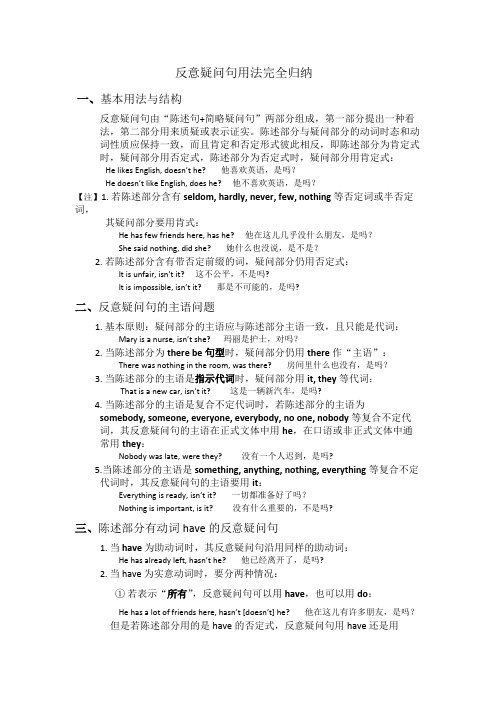
反意疑问句用法完全归纳一、基本用法与结构反意疑问句由“陈述句+简略疑问句”两部分组成,第一部分提出一种看法,第二部分用来质疑或表示证实。
陈述部分与疑问部分的动词时态和动词性质应保持一致,而且肯定和否定形式彼此相反,即陈述部分为肯定式时,疑问部分用否定式,陈述部分为否定式时,疑问部分用肯定式:He likes English, doesn’t he? 他喜欢英语,是吗?He doesn’t like English, does he? 他不喜欢英语,是吗?【注】1. 若陈述部分含有seldom, hardly, never, few, nothing等否定词或半否定词,其疑问部分要用肯式:He has few friends here, has he? 他在这儿几乎没什么朋友,是吗?She said nothing, did she? 她什么也没说,是不是?2. 若陈述部分含有带否定前缀的词,疑问部分仍用否定式:It is unfair, isn’t it? 这不公平,不是吗?It is impossible, isn’t it? 那是不可能的,是吗?二、反意疑问句的主语问题1. 基本原则:疑问部分的主语应与陈述部分主语一致,且只能是代词:Mary is a nurse, isn’t she? 玛丽是护士,对吗?2. 当陈述部分为there be句型时,疑问部分仍用there作“主语”:There was nothing in the room, was there? 房间里什么也没有,是吗?3. 当陈述部分的主语是指示代词时,疑问部分用it, they等代词:That is a new car, isn’t it? 这是一辆新汽车,是吗?4. 当陈述部分的主语是复合不定代词时,若陈述部分的主语为somebody, someone, everyone, everybody, no one, nobody等复合不定代词,其反意疑问句的主语在正式文体中用he,在口语或非正式文体中通常用they:Nobody was late, were they? 没有一个人迟到,是吗?5.当陈述部分的主语是 something, anything, nothing, everything等复合不定代词时,其反意疑问句的主语要用it:Everything is ready, isn’t it? 一切都准备好了吗?Nothing is important, is it? 没有什么重要的,不是吗?三、陈述部分有动词have的反意疑问句1. 当have 为助动词时,其反意疑问句沿用同样的助动词:He has already left, hasn’t he? 他已经离开了,是吗?2. 当 have 为实意动词时,要分两种情况:①若表示“所有”,反意疑问句可以用have,也可以用do:He has a lot of friends here, hasn’t [doesn’t] he? 他在这儿有许多朋友,是吗?但是若陈述部分用的是have的否定式,反意疑问句用have 还是用do,取决于陈述部分的动词形式:He hasn’t any money, has he? 他没有钱,是吗?He doesn’t have any money, does he? 他没有钱,是吗?②若表示“吃”、“玩”等意思,反意疑问句要用do:He has supper at 5, doesn’t he? 他5点吃晚餐,是吗?He had a good time at the party, didn’t he? 他在晚会上玩得很开心,是吗?3. 当用于have to时,通常也有两种可能:若表示经常性的行为,则多用加助动词do的形式;若表示特定的行为,则多用have:He often has to get up early, doesn’t he? 他经常要早起,是吗?He has to go to bed late tonight, hasn’t he? 他今晚要迟睡,是吗?四、含情态动词的反意疑问句1. 基本原则:在通常情况下,当陈述部分含有情态动词时,疑问部分会重复前面同样的情态动词:He can speak English, can’t he?他会说英语,是吗?We shouldn’t go, should we? 我们不应该去,对不对?2. 当陈述部分含有must时,要分两种情况:①若must表示“必须”或“有必要”,疑问部分用mustn’t或needn’t:You must leave at once, mustn’t [needn’t] you? 你必须(有必要)马上离开,是吗?但是若陈述部分有mustn’t表示禁止,疑问部分要must:You mustn’t laugh, must you? 你不准笑,知道吗?②若must表示推测,疑问部分不能用must,而应根据must后的动词结构采用相应的动词形式:He must be tired, isn’t he? 他一定累了,是吗?五、陈述部分为祈使句的反意疑问句1. 基本原则:若陈述部分为祈使句,疑问部分通常用will you:Please help us, will you? 请帮帮我们,好吗?Come with us, will you? 同我们一起去,好吗?Don’t forget to post the letter, will you? 请别忘了寄信。
初中英语反义疑问句的用法与例句知识点

初中英语反义疑问句的用法与例句知识点在咱们初中英语的学习中啊,反义疑问句这个知识点可真是让人又爱又恨。
今天,我就来给大家好好说道说道。
先来说说啥是反义疑问句。
简单来讲,就是在一个陈述句后面再加上一个简短的问句,用来确认或者求证前面陈述句所说的内容。
比如说,“You are a student, aren't you?” 这里前面说“你是个学生”,后面就问“不是吗”。
那反义疑问句的构成是咋样的呢?一般来说,就是“陈述句+简短问句”。
这个简短问句由“助动词/情态动词/be 动词+主语(人称代词)”构成。
而且要注意哦,前肯后否,前否后肯。
啥意思呢?就是前面陈述句是肯定的,后面问句就得是否定的;前面陈述句是否定的,后面问句就得是肯定的。
举个例子哈,“He likes music, doesn't he?” 前面说“他喜欢音乐”是肯定的,后面就问“不是吗”,用否定“doesn't he”。
再比如,“She isn't beautiful, is she?” 前面说“她不漂亮”是否定的,后面就得问“漂亮吗”,用肯定“is she”。
还有啊,反义疑问句的回答也有点讲究。
别看到后面的问句是否定的,就晕头转向。
回答的时候,根据实际情况来,是就是“yes”,不是就是“no”,别管问句是肯定还是否定。
比如说,有人问你“You are fromChina, aren't you?” 如果你确实来自中国,那就回答“Yes, I am” 可别因为后面是“aren't you”就搞糊涂啦。
我还记得我上初中那会,有一次英语课上,老师正在讲反义疑问句。
当时老师举了个例子,“You have finished your homework, haven't you?”然后老师就点了我同桌起来回答。
我那同桌啊,平时英语就不太好,站起来一脸懵。
支支吾吾半天,最后来了一句:“I don't know” 全班同学都笑了,老师也哭笑不得,又给他耐心地解释了一遍。
英语中反义疑问句的用法归纳

英语中反义疑问句的用法归纳反义疑问句用法归纳一、基本概念反义疑问句由两部分组成:前一部分是一个陈述句,后一部分是一个简短的疑问句,两部分的人称和时态应保持一致。
二、基本用法1. 肯定陈述句 + 否定疑问句例如:You like music, don't you? (你喜欢音乐,不是吗?)2. 否定陈述句 + 肯定疑问句例如:He doesn't like sports, does he? (他不喜欢运动,是吗?)3. 祈使句 + 反义疑问句(1)Let's 开头的祈使句,用 shall we?例如:Let's go for a walk, shall we? (我们去散步,好吗?)(2)Let us 开头的祈使句,用 will you?例如:Let us have a rest, will you? (让我们休息一下,好吗?)(3)其他祈使句,用 will you?例如:Open the door, will you? (打开门,好吗?)4. 含有 must 的反义疑问句(1)must 表示“必须”时,用 needn't例如:You must finish your homework today, needn't you? (你今天必须完成作业,不是吗?)(2)must 表示推测“一定,肯定”时,根据实际情况而定例如:He must be very tired, isn't he? (他一定很累了,不是吗?)5. 含有否定词的反义疑问句当陈述句中有 never, few, little, nothing, nobody 等否定词时,反义疑问句用肯定形式。
例如:There is nothing in the box, is there? (盒子里什么都没有,是吗?)三、固定搭配1. “I am + 表语”,反义疑问句用“aren't I”例如:I'm late, aren't I? (我迟到了,不是吗?)2. 陈述部分是“there be”结构,反义疑问句用“be there”例如:There is a book on the desk, isn't there? (桌子上有一本书,不是吗?)3. 当陈述部分主语是不定代词 everyone, somebody, nobody, everyone 等时,反义疑问句用 they 或 he例如:Everyone is here, aren't they? (大家都在这儿,不是吗?)4. 当陈述部分主语是 this, that 时,反义疑问句用 it;当陈述部分主语是 these, those 时,反义疑问句用 they例如:This is a pen, isn't it? (这是一支钢笔,不是吗?)5. 当陈述部分是主从复合句时,反义疑问句与主句的主语和谓语保持一致例如:He said he would come, didn't he? (他说他会来,不是吗?)双语例句:1. I have a lot of friends, don't I? (我有很多朋友,不是吗?)2. She doesn't speak French, does she? (她不会说法语,是吗?)3. Have a cup of coffee, will you? (喝杯咖啡,好吗?)4. We should study hard, shouldn't we? (我们应该努力学习,不是吗?)5. They have been to Beijing, haven't they? (他们去过北京,不是吗?)6. You aren't a doctor, are you? (你不是医生,对吧?)7. There are some apples on the tree, aren't there? (树上有一些苹果,不是吗?)8. Nobody knows the answer, do they? (没人知道答案,对吧?)9. This isn't your book, is it? (这不是你的书,对吧?)10. Those are beautiful flowers, aren't they? (那些是漂亮的花,不是吗?)11. He can swim very well, can't he? (他游泳游得很好,不是吗?)12. She never tells lies, does she? (她从不说谎,对吧?)13. We had a great time yesterday, didn't we? (我们昨天玩得很开心,不是吗?)14. If it rains tomorrow, we won't go hiking, will we? (如果明天下雨,我们就不去徒步了,对吧?)15. You think he is right, don't you? (你认为他是对的,不是吗?)16. Mary has few friends here, does she? (玛丽在这儿几乎没朋友,对吧?)17. The boy doesn't like vegetables, does he? (这男孩不喜欢蔬菜,是吗?)18. Everyone wants to be happy, don't they? (每个人都想快乐,不是吗?)19. I'm a good student, aren't I? (我是个好学生,不是吗?)20. He told you the truth, didn't he? (他告诉你真相了,不是吗?)。
2024年初中英语语法一轮复习之反义疑问句用法归纳
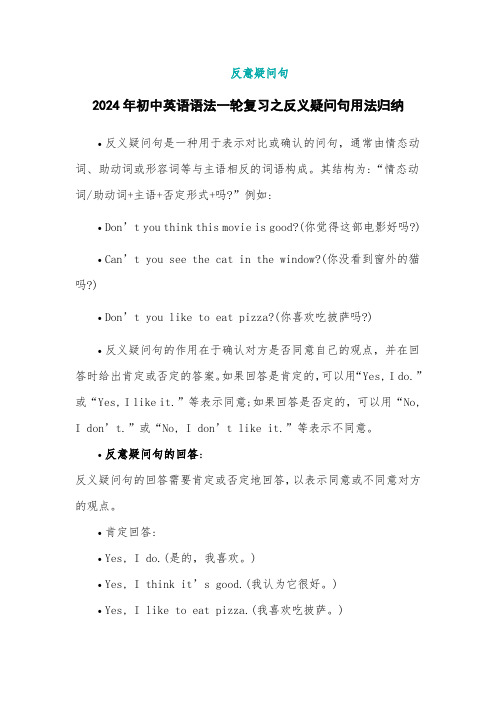
反意疑问句2024年初中英语语法一轮复习之反义疑问句用法归纳•反义疑问句是一种用于表示对比或确认的问句,通常由情态动词、助动词或形容词等与主语相反的词语构成。
其结构为:“情态动词/助动词+主语+否定形式+吗?”例如:•Don’t you think this movie is good?(你觉得这部电影好吗?) •Can’t you see the cat in the window?(你没看到窗外的猫吗?)•Don’t you like to eat pizza?(你喜欢吃披萨吗?)•反义疑问句的作用在于确认对方是否同意自己的观点,并在回答时给出肯定或否定的答案。
如果回答是肯定的,可以用“Yes, I do.”或“Yes, I like it.”等表示同意;如果回答是否定的,可以用“No, I don’t.”或“No, I don’t like it.”等表示不同意。
•反意疑问句的回答:反义疑问句的回答需要肯定或否定地回答,以表示同意或不同意对方的观点。
•肯定回答:•Yes, I do.(是的,我喜欢。
)•Yes, I think it’s good.(我认为它很好。
)•Yes, I like to eat pizza.(我喜欢吃披萨。
)•否定回答:•No, I don’t.(不,我不喜欢。
)•No, I don’t think it’s good.(不,我觉得它不好。
)•No, I don’t like to eat pizza.(不,我不喜欢吃披萨。
) •需要注意的是,在回答反义疑问句时,应该使用正确的语法和标点符号,以确保回答的准确性和清晰度。
回答反义疑问句的原则回答反义疑问句的原则是:肯定回答用“Yes, I do.”或“Yes, I think it’s good.”等表示同意;否定回答用“No, I don’t.”或“No, I don’t think it’s good.”等表示不同意。
反义疑问句的用法归纳及回答举例初中
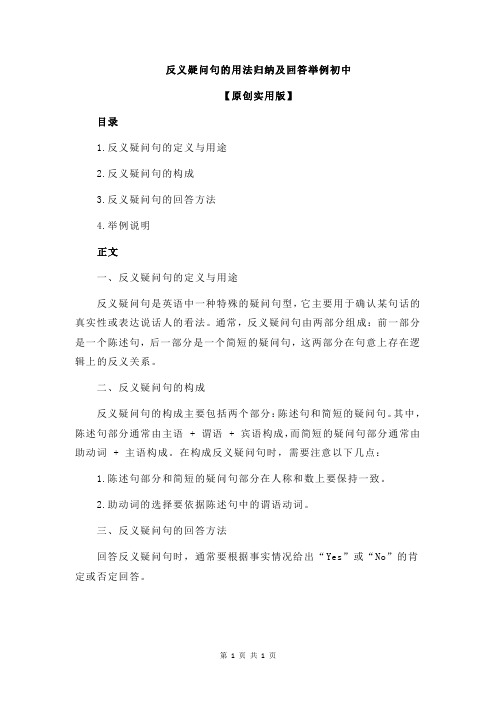
反义疑问句的用法归纳及回答举例初中
【原创实用版】
目录
1.反义疑问句的定义与用途
2.反义疑问句的构成
3.反义疑问句的回答方法
4.举例说明
正文
一、反义疑问句的定义与用途
反义疑问句是英语中一种特殊的疑问句型,它主要用于确认某句话的真实性或表达说话人的看法。
通常,反义疑问句由两部分组成:前一部分是一个陈述句,后一部分是一个简短的疑问句,这两部分在句意上存在逻辑上的反义关系。
二、反义疑问句的构成
反义疑问句的构成主要包括两个部分:陈述句和简短的疑问句。
其中,陈述句部分通常由主语 + 谓语 + 宾语构成,而简短的疑问句部分通常由助动词 + 主语构成。
在构成反义疑问句时,需要注意以下几点:
1.陈述句部分和简短的疑问句部分在人称和数上要保持一致。
2.助动词的选择要依据陈述句中的谓语动词。
三、反义疑问句的回答方法
回答反义疑问句时,通常要根据事实情况给出“Yes”或“No”的肯定或否定回答。
第1页共1页。
初中英语反义疑问句的用法归纳

初一反义疑问句【反义疑问句】〔一〕概念: 反意疑问句是由陈述句和附在其后的附加疑问句组成。
其中附加疑问句是对陈述句所说的事实或观点提出疑问, 起证实作用, 一般用于证实说话者所说的事实或观点。
〔二〕要点注意:1.反意疑问句前后两局部谓语应是: “肯定陈述+否认疑问〞或“否认陈述+肯定疑问〞。
2.简单问句如果是否认式: not应与be, do, will等系动词、助动词、情态动词缩写。
3.简单问句的主语不用名词, 应用人称代词。
4、陈述局部含“too...to〞时, 是否认句。
〔三〕用法:1) 陈述局部I am时, 疑问局部要用aren't I.I'm as tall as your sister, aren't I" 〔我和你姐姐一样高, 对吗?〕2) 陈述局部用no, nothing, nobody, never, few, little, seldom, hardly等否认含义的词时, 疑问局部用肯定含义。
如:The old man made no answer, did he"Jim is never late for school, is he"3) 陈述局部有情态动词have to +v.(had to + v.), 疑问局部常用don't +主语〔didn't +主语〕。
We have to get there at eight tomorrow, don't we"used to, 疑问局部用didn't +主语或usedn't +主语。
He used to take pictures there, didn't he" / usedn't he"had better〔最好〕+ v.疑问句局部用hadn't you"You'd better read it by yourself, hadn't you"4) 陈述局部有would rather〔宁可、宁愿〕+v., 疑问局部多用wouldn't +主语。
初中反义疑问句的用法归纳总结
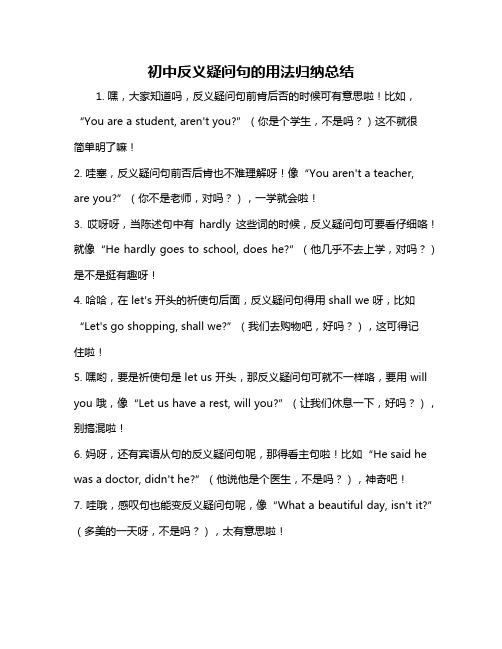
初中反义疑问句的用法归纳总结1. 嘿,大家知道吗,反义疑问句前肯后否的时候可有意思啦!比如,“You are a student, aren't you?”(你是个学生,不是吗?)这不就很简单明了嘛!2. 哇塞,反义疑问句前否后肯也不难理解呀!像“You aren't a teacher, are you?”(你不是老师,对吗?),一学就会啦!3. 哎呀呀,当陈述句中有hardly 这些词的时候,反义疑问句可要看仔细咯!就像“He hardly goes to school, does he?”(他几乎不去上学,对吗?)是不是挺有趣呀!4. 哈哈,在 let's 开头的祈使句后面,反义疑问句得用 shall we 呀,比如“Let's go shopping, shall we?”(我们去购物吧,好吗?),这可得记住啦!5. 嘿哟,要是祈使句是 let us 开头,那反义疑问句可就不一样咯,要用 will you 哦,像“Let us have a rest, will you?”(让我们休息一下,好吗?),别搞混啦!6. 妈呀,还有宾语从句的反义疑问句呢,那得看主句啦!比如“He said he was a doctor, didn't he?”(他说他是个医生,不是吗?),神奇吧!7. 哇哦,感叹句也能变反义疑问句呢,像“What a beautiful day, isn't it?”(多美的一天呀,不是吗?),太有意思啦!8. 嘿嘿,否定前移的句子,反义疑问句得跟着从句走哦,像“I don't think he is right, is he?”(我不认为他是对的,是吗?),是不是很特别呀!9. 呀,大家一定要好好掌握初中反义疑问句的这些用法呀,真的很有用的呢!以后做题就不会错啦!我的观点结论:初中反义疑问句的用法虽然多样,但只要认真理解和记忆这些要点,就能轻松掌握啦!。
反义疑问句(含解析、例句及详尽用法)
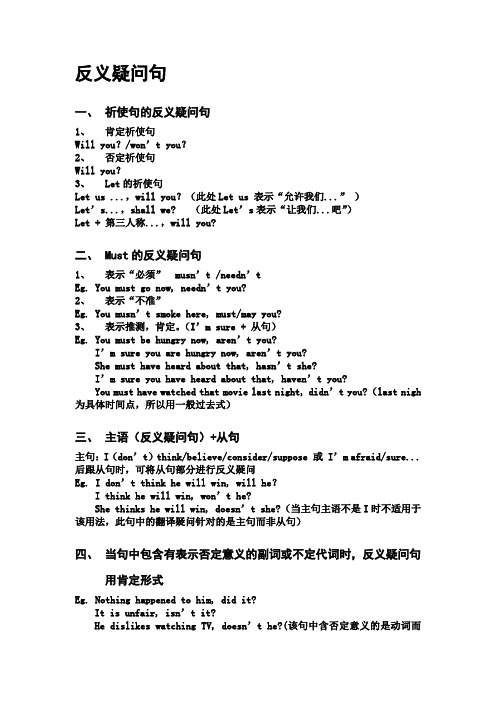
反义疑问句一、祈使句的反义疑问句1、肯定祈使句Will you?/won’t you?2、否定祈使句Will you?3、Let的祈使句Let us ...,will you?(此处Let us 表示“允许我们...”)Let’s...,shall we? (此处Let’s表示“让我们...吧”)Let + 第三人称...,will you?二、Must的反义疑问句1、表示“必须” musn’t /needn’tEg. You must go now, needn’t you?2、表示“不准”Eg. You musn’t smoke here, must/may you?3、表示推测,肯定。
(I’m sure + 从句)Eg. You must be hungry now, aren’t you?I’m sure you are hungry now, aren’t you?She must have heard about that, hasn’t she?I’m sure you have heard about that, haven’t you?You must have watched that movie last night, didn’t you?(last nigh 为具体时间点,所以用一般过去式)三、主语(反义疑问句)+从句主句:I(don’t)think/believe/consider/suppose 或 I’m afraid/sure...后跟从句时,可将从句部分进行反义疑问Eg. I don’t think he will win, will he?I think he will win, won’t he?She thinks he will win, doesn’t she?(当主句主语不是I时不适用于该用法,此句中的翻译疑问针对的是主句而非从句)四、当句中包含有表示否定意义的副词或不定代词时,反义疑问句用肯定形式Eg. Nothing happened to him, did it?It is unfair, isn’t it?He dislikes watching TV, doesn’t he?(该句中含否定意义的是动词而非副词或不定代词,因此不适用于该用法,反义疑问句仍然使用否定形式)五、反义疑问句的回答反义疑问句的回答针对被提问部分的谓语动词,且与回答句前部分的Yes和No 保持一致Eg. A: You haven’t lost the ticket, have you?B: D I know it’s hard to get another one at this moment.A. Yes, I haven’tB. No, I haveC. I hope soD. I’m afraid not六、陈述部分的主语与反义疑问句主语保持一致的情况1、OneEg. One can’t be too careful when driving a car, can one/he?一个人在开车的时候再怎么小心也不为过。
初中英语知识点归纳反意疑问句的构成和用法

初中英语知识点归纳反意疑问句的构成和用法反意疑问句是英语中一种特殊的疑问句形式,它由一个陈述句和一个简短的疑问句构成。
它的用法非常广泛,并且在交流中起到了重要的作用。
本文将对初中英语中关于反意疑问句的知识点进行归纳和总结。
一、反意疑问句的构成反意疑问句由一个陈述句和一个简短的疑问句构成。
其中陈述句和疑问句的主谓结构是相反的,即如果陈述句的主语是肯定形式,那么疑问句的主语就是否定形式,反之亦然。
同时,疑问句的谓语动词一般是由陈述句的谓语动词的助动词或情态动词构成。
例如:陈述句:You can swim.疑问句:You can swim, can't you?陈述句:He didn't go to the party.疑问句:He didn't go to the party, did he?二、反意疑问句的用法1. 反意疑问句用于征求对方的同意或确认,常常表达说话人的期望、希望或疑虑等。
例如:You will come to the meeting, won't you?(你会来参加会议的,对吧?)2. 反意疑问句用于提出建议或请求,希望得到对方的回答。
例如:Let's go for a walk, shall we?(我们出去散步吧,好吗?)3. 反意疑问句用于询问对方的意见或看法。
例如:You like the movie, don't you?(你喜欢这部电影,对吗?)4. 反意疑问句也可用于推测或肯定自己的观点,并希望对方表示赞同或不赞同。
例如:It's a beautiful day, isn't it?(今天天气很好,对吧?)You must be tired, aren't you?(你一定很累了,对吗?)三、注意事项在构成和使用反意疑问句时,还需注意以下几个问题:1. 主语一致原则:主语一致原则要求疑问句和陈述句的主语一致,即如果陈述句的主语是第一人称,那么疑问句的主语也应该是第一人称,反之亦然。
反义疑问句的用法归纳及习题
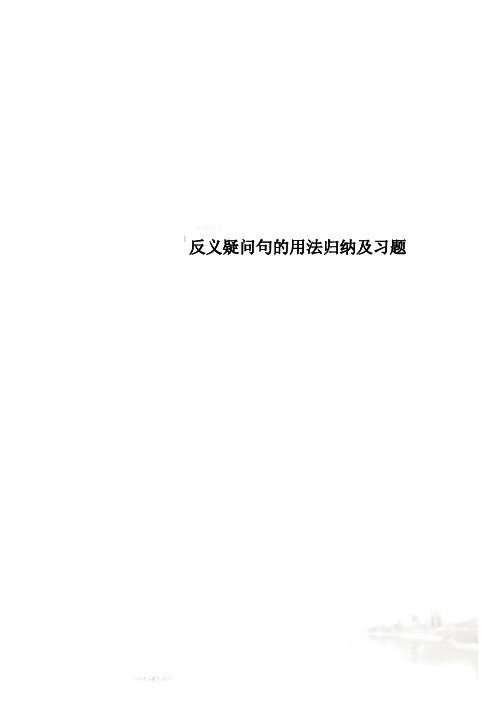
反义疑问句的用法归纳及习题反意疑问句【反意疑问句】(一)概念:反意疑问句是由陈述句和附在其后的附加疑问句组成。
其中附加疑问句是对陈述句所说的事实或观点提出疑问,起证实作用,一般用于证实说话者所说的事实或观点。
(二)要点注意:1、反意疑问句前后两部分谓语应是:“肯定陈述+否定疑问”或“否定陈述+肯定疑问”。
2、简略问句如果是否定式:not应与be,do,will 等系动词、助动词、情态动词缩写。
3、简略问句的主语不用名词,应用人称代词。
4、陈述部分含“too...to”时,是否定句。
(三)用法:1) 陈述部分I am时,疑问部分要用aren't I.I'm as tall as your sister,aren't I?(我和你姐姐一样高,对吗?)2) 陈述部分用no, nothing, nobody, never, few, little, seldom, rarely,hardly等否定含义的词时,疑问部分用肯定含义。
如:The old man made no answer, did he?Jim is never late for school, is he?3) 陈述部分有情态动词have to +v. (had to + v.),疑问部分常用don't +主语(didn't +主语)。
We have to get there at eight tomorrow, don't we?used to,疑问部分用didn't +主语或usedn't +主语。
He used to take pictures there, didn't he? / usedn't he?had better(最好)+ v. 疑问句部分用hadn't you?You'd better read it by yourself, hadn't you?4) 陈述部分有would rather(宁可、宁愿)+v.,疑问部分多用wouldn't +主语。
英语反义疑问句的用法归纳总结
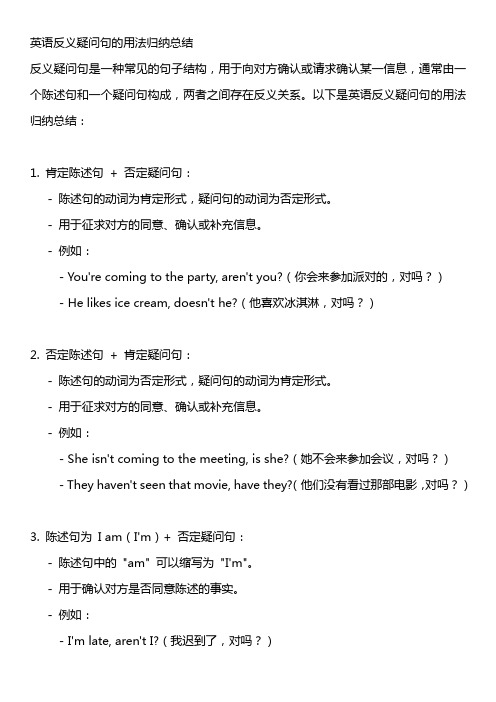
英语反义疑问句的用法归纳总结反义疑问句是一种常见的句子结构,用于向对方确认或请求确认某一信息,通常由一个陈述句和一个疑问句构成,两者之间存在反义关系。
以下是英语反义疑问句的用法归纳总结:1. 肯定陈述句+ 否定疑问句:- 陈述句的动词为肯定形式,疑问句的动词为否定形式。
- 用于征求对方的同意、确认或补充信息。
- 例如:- You're coming to the party, aren't you?(你会来参加派对的,对吗?)- He likes ice cream, doesn't he?(他喜欢冰淇淋,对吗?)2. 否定陈述句+ 肯定疑问句:- 陈述句的动词为否定形式,疑问句的动词为肯定形式。
- 用于征求对方的同意、确认或补充信息。
- 例如:- She isn't coming to the meeting, is she?(她不会来参加会议,对吗?)- They haven't seen that movie, have they?(他们没有看过那部电影,对吗?)3. 陈述句为I am(I'm)+ 否定疑问句:- 陈述句中的"am" 可以缩写为"I'm"。
- 用于确认对方是否同意陈述的事实。
- 例如:- I'm late, aren't I?(我迟到了,对吗?)4. 陈述句中有情态动词+ 肯定疑问句:- 陈述句中有情态动词(如can, could, will, would, should, must等),疑问句的情态动词要与陈述句保持一致。
- 用于确认对方是否同意或能够遵从陈述中的情态动词。
- 例如:- He can swim, can't he?(他会游泳,对吗?)- You will help me, won't you?(你会帮助我,对吗?)5. 陈述句中没有情态动词+ 肯定疑问句:- 陈述句中没有情态动词,疑问句使用"do/does/did" 作为助动词,并保持句子时态一致。
初二英语语法-反义疑问句讲解及练习
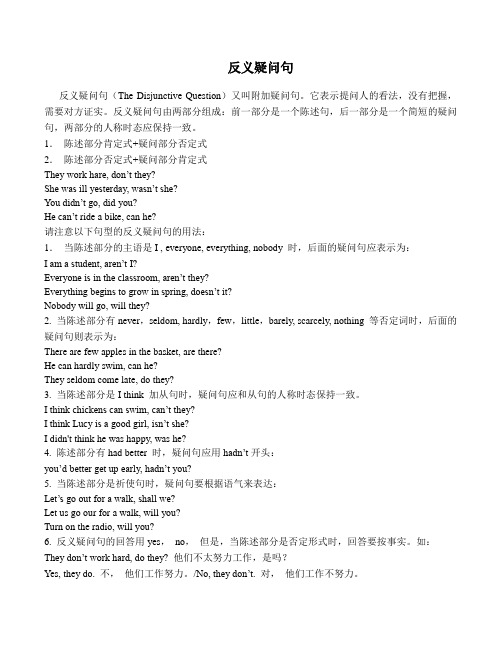
反义疑问句反义疑问句(The Disjunctive Question)又叫附加疑问句。
它表示提问人的看法,没有把握,需要对方证实。
反义疑问句由两部分组成:前一部分是一个陈述句,后一部分是一个简短的疑问句,两部分的人称时态应保持一致。
1.陈述部分肯定式+疑问部分否定式2.陈述部分否定式+疑问部分肯定式They work hare, don’t they?She was ill yesterday, wasn’t she?You didn’t go, did you?He can’t ride a bike, can he?请注意以下句型的反义疑问句的用法:1.当陈述部分的主语是I , everyone, everything, nobody 时,后面的疑问句应表示为:I am a student, aren’t I?Everyone is in the classroom, aren’t they?Everything begins to grow in spring, doesn’t it?Nobody will go, will they?2. 当陈述部分有never,seldom, hardly,few,little,barely, scarcely, nothing 等否定词时,后面的疑问句则表示为:There are few apples in the basket, are there?He can hardly swim, can he?They seldom come late, do they?3. 当陈述部分是I think 加从句时,疑问句应和从句的人称时态保持一致。
I think chickens can swim, can’t they?I think Lucy is a good girl, isn’t she?I didn't think he was happy, was he?4. 陈述部分有had better 时,疑问句应用hadn’t开头:you’d better get up early, hadn’t you?5. 当陈述部分是祈使句时,疑问句要根据语气来表达:Let’s go out for a walk, shall we?Let us go our for a walk, will you?Turn on the radio, will you?6. 反义疑问句的回答用yes,no,但是,当陈述部分是否定形式时,回答要按事实。
- 1、下载文档前请自行甄别文档内容的完整性,平台不提供额外的编辑、内容补充、找答案等附加服务。
- 2、"仅部分预览"的文档,不可在线预览部分如存在完整性等问题,可反馈申请退款(可完整预览的文档不适用该条件!)。
- 3、如文档侵犯您的权益,请联系客服反馈,我们会尽快为您处理(人工客服工作时间:9:00-18:30)。
反义疑问句归纳(1)反意疑问句要点简述反意疑问句又叫附加疑问句,是在陈述句后,对陈述句所叙述的事实提出的疑问。
其基本结构有两种:一是“肯定陈述句+简略否定问句”;二是“否定陈述句+简略肯定问句”。
反意疑问句后一部分的主谓与前一部分的主谓要保持人称及助动词等方面的一致。
这种疑问句的回答要根据事实,肯定的用“Y es, …”。
否定的用“No, …”。
如:It looks like rain, doesn’t it?He doesn’t need to work so late, does he?(2)学习反意疑问句,特别要注意的问题1)陈述部分的主语是this, that时,疑问部分的主语多用it;陈述部分的主语是these, those时,疑问部分的主语多用they。
如:This is a dictionary, isn’t it?Those are shelves, aren’t they?2)陈述句如果是there be结构时,疑问句部分仍用there。
如:There once was a man named Saint Nicholas, wasn’t there?3)在英语口语中,“I am +表语结构”,后面的反意疑问句多用aren’t I来体现。
如:I am very interested in learning English, aren’t I?4)陈述句的主语是动词不定式,动词的-ing形式或从句时,疑问部分的主语多用it来体现。
如:Taking care of our environment is very important, isn’t it?What he said is right, isn’t it?5)陈述句中含有not, no, hardly, neither, never, few, little, too …to等否定词或具有否定意义的词时,疑问部分常用肯定形式。
如:Few people knew the news, did they?Tom has never been to England, has he?但陈述句中如果带有否定意义的前缀和后缀的单词时,整个句子仍视为肯定句,反意疑问部分多用否定形式。
如:She is unhappy, isn’t she?6)陈述句的主语是nobody, no one, everyone, somebody等不定代词时,反意疑问部分的主语多用they(当强调全体时)或he(当强调个体时)。
如果陈述句的主语是something, nothing, anything, everything等不定代词时,反意疑问部分的主语多用it。
如:No one knows him, do they?Someone is waiting for you, isn’t he?Nobody says a word about the accident, do they?Everything seems all right, doesn’t it?7)陈述句是主从复合句时,如果主句的谓语动词是think, believe, expect, feel, guess等词,且主语是第一人称I或we时,反意疑问部分的人称、时态与宾语从句保持一致,同时还要考虑到否定的转移(否定前移)。
如:I believe that the boy can get a ticket for you, can’t he?I don't think he is bright, is he?We believe she can do it better, can't she?若是第二第三人称的话,反义疑问句应该看主句:She thought it is meaningless,didn't she?如果是转述的要注意:He said that you were in hospital,weren't you?(这里是对着那个you说的)8)祈使句的反义疑问句中:let's 的要用shall we;let us 的要用will you;其他形式的都用will you。
如:Go and get it for me, won't you?去帮我取个东西,好吗?Let's meet at the airport, shall we ? 我们在机场碰头,行不行?Have a little more wine, will you ? 喝点儿酒,好吗?9)must的反义疑问句:陈述部分有must 的疑问句,疑问部分根据实际情况而定。
A.must表示“应该”,其疑问部分用mustn't(不应该),如:Y ou must work hard next term, mustn't you ? 下学期你应该努力学习,对吗?B.must表示“必须”,其疑问部分用needn't(不必),如:They must finish the work today, needn’t they? 他们今天必须要完成这项工作,是吗?C.陈述部分含情态动词mustn't,表示禁止时,疑问部分就可以用must或may,如:Y ou mustn’t stop your car here, must you? (may we?)你不能把车停在这地方,知道吗?D.must表示推测,其疑问部分必须与must 后面的主要动词相呼应。
如:①对现在动作或存在的情况的推测:Y ou must know the answer to the exercise, don't you? 你一定知道这项练习的答案,是不是?That must be your bed, isn't it? 那一定是你的床,是吗?②对过去发生的动作或存在的情况的推测:句中陈述部分没有表示过去的时间状语,这时疑问部分中的动词就用现在完成时。
(haven’t / hasn’t + 主语)Y ou must have told her about it, haven’t you? 你一定把这事告诉她了,是吗?10)have作为动词的反义疑问句:①have to 的短语,且只充当一般动词的作用,助动词为do,does,和普通的一般疑问句没有任何差别,提问还是用do,does引导。
We have to finish it ,don't we?②当用have,has做助动词的时候,疑问句才用它们引导,如:She has seen it,hasn't she?这里的助动词就是has③当陈述部分有had better,或其中的have表示完成时态时,疑问句应用hadn’t等开头:Y ou’d better get up early, hadn’t you?④其他情况句中有have时疑问句应用don't等开头;如have表示“有”的时候,有两种形式:do或haveHe has two sisters,doesn't he? =He has two sisters,hasn't he?He doesn't have any sisters, does he?⑤当must+have done表示对过去的情况进行推测(一般句中有明确的过去时间状语),问句要根据陈述部分谓语的情况用“didn't+主语”或“wasn't/weren't+主语”;如果强调动作的完成(一般没有明确的过去时间状语),问句要用“haven't/hasn't+主语”。
She must have read the novel last week,didn't she? 她上星期一定读了这本小说,是吗?Y ou must have told her about it, haven't you?你一定把这事告诉她了,是吗?11)带情态动词dare或need的反意疑问句,疑问部分常用 need (dare ) +主语。
We need not do it again, need we ?He dare not say so, dare you?当dare, need 为实义动词时,疑问部分用助动词do + 主语。
She doesn't dare to go home alone, does she?12)感叹句中,疑问部分用be +主语。
What colours, aren't they?What a smell, isn't it?13)陈述部分由neither…nor, either…or 连接的并列主语时,疑问部分根据其实际逻辑意义而定。
Neither you nor I am engineer, are we?14)陈述部分的谓语是wish,疑问部分要用may +主语。
I wish to have a word with you, may I?15)含有ought to 的反意疑问句,陈述部分是肯定的,疑问部分用shouldn't / oughtn't +主语。
He ought to know what to do, oughtn't he? / shouldn't he?16)陈述部分的谓语是used to 时,疑问部分用didn't +主语或usedn't +主语。
He used to take pictures there, didn't he? / usedn't he?17)陈述部分有would rather +v.,疑问部分多用wouldn't +主语。
He would rather read it ten times than recite it, wouldn't he?18)陈述部分有Y ou'd like to +v. 疑问部分用wouldn't +主语。
Y ou'd like to go with me, wouldn't you?对反意疑问句的回答,无论问题的提法如何,如果事实是肯定的,就用yes,事实是否定的,就要用no。
要特别注意陈述句部分是否定结构,反意疑问句部分用肯定式提问时,回答yes或no与汉语正好相反。
这种省略回答的yes要译成“不”,no要译成“是”。
例---He likes playing football, doesn’t he? 他喜欢踢足球,是吗?---Y es, he does. / No, he doesn’t. 是的。
